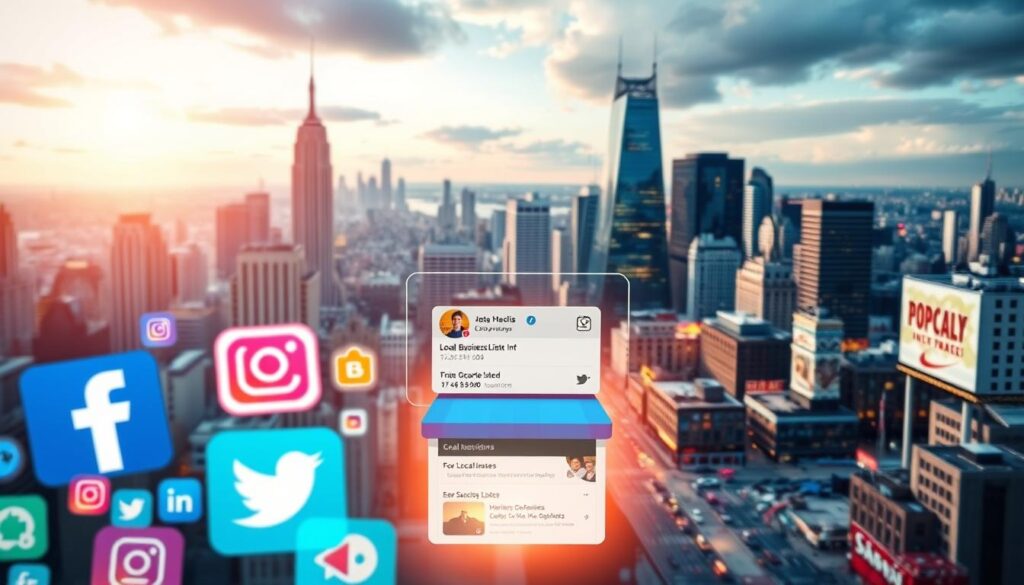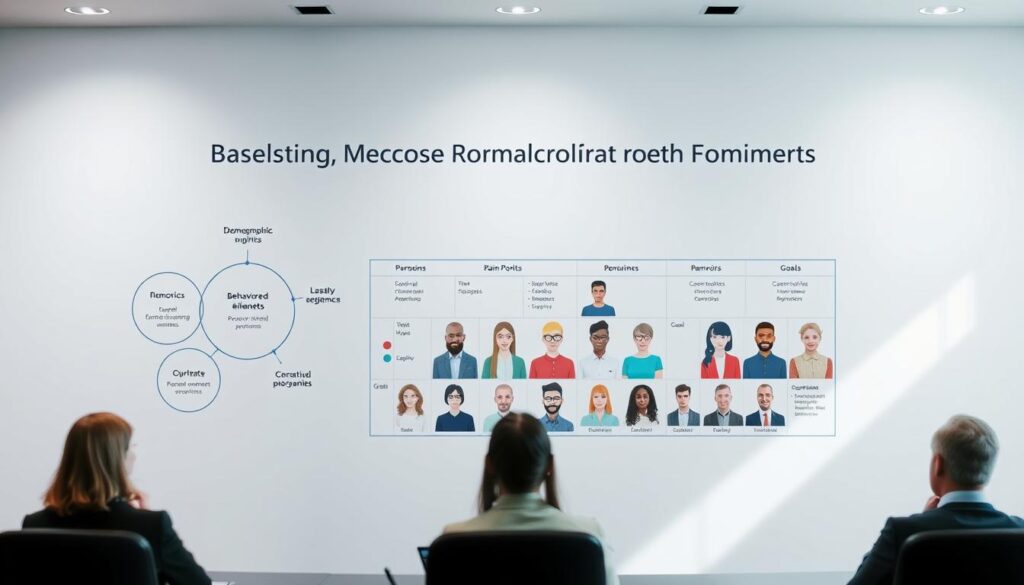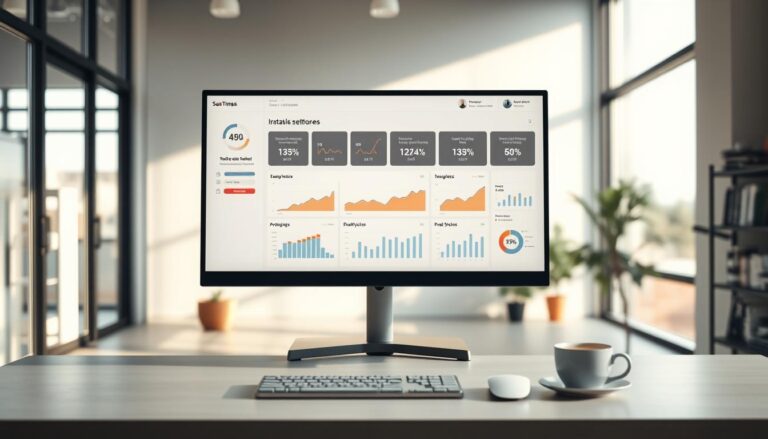Connecting with nearby customers has never been more critical. Research reveals 74% of shoppers visit stores based on online discoveries, with most transactions occurring within 15 minutes of home or work. This proximity-driven economy creates unique opportunities for community-focused enterprises to thrive.
The digital age rewards those who appear where searchers look first. A staggering 72% of consumers visit establishments within five miles after searching – a trend reshaping how companies approach growth. Strategic online positioning now outweighs broad national campaigns for smaller organizations.
Building visibility requires more than basic advertising. It demands curated digital footprints across platforms like free business directories that amplify neighborhood presence. These tools help enterprises target hyper-local audiences without large budgets, creating meaningful connections that drive foot traffic and loyalty.
Key Takeaways
- 74% of consumers visit stores based on online discoveries
- 72% of local searches result in visits to nearby businesses
- Digital proximity matters more than national brand recognition
- Strategic directory placement boosts visibility cost-effectively
- Community-focused approaches outperform generic marketing tactics
Introduction: The Power of Local Business Listings
Geographic relevance now determines which companies capture today’s on-demand shoppers. Neighborhood-focused enterprises thrive by aligning with consumer patterns shaped by daily commutes, lunch breaks, and weekend errands. This hyper-local dynamic creates fertile ground for strategic visibility efforts.
Understanding the Local Market
Proximity-driven shopping habits reveal a clear pattern: 68% of consumers choose establishments near their regular routes. Morning coffee stops, after-work services, and weekend leisure activities all follow geographic logic. Enterprises that map their visibility to these routines gain inherent advantages.
| Marketing Approach | Reach | Cost Efficiency |
|---|---|---|
| Billboard Ads | Broad | Low |
| Social Media Campaigns | Targeted | High |
| Directory Listings | Hyper-Local | Maximum |
The Role of Digital Advertising
Modern promotional tools enable precise audience targeting without large budgets. Platforms like Google Ads and Facebook allow neighborhood-specific campaigns that highlight special offers or seasonal events. These methods complement traditional outreach while delivering measurable results.
Three elements define successful local campaigns:
- Real-time responsiveness to community trends
- Consistent presence across multiple platforms
- Clear calls-to-action for immediate engagement
This strategic alignment between consumer behavior and digital accessibility forms the foundation for sustainable growth. When executed effectively, these techniques transform casual searchers into loyal patrons.
The Importance of Local Visibility for Small Businesses
Proximity powers modern commerce – 63% of purchases happen within a 15-minute radius of daily routines. For neighborhood enterprises, this creates both opportunity and challenge. Traditional advertising often drains budgets without guaranteeing nearby engagement.
Strategic directory placements solve this dilemma. They position establishments exactly where potential customers look first – digital hubs mapping services to immediate needs. A coffee shop appearing in “near me” searches gains 3x more walk-ins than competitors relying solely on signage.
Consumer patterns reveal why this works. People prioritize convenience over brand loyalty when time-sensitive needs arise.
“Same-day searches convert 28% faster than general inquiries,”
notes a 2023 retail study. This urgency makes hyper-targeted visibility essential for capturing spontaneous buyers.
Smaller companies benefit from reduced competition in micro-markets. While national chains dominate broad search terms, neighborhood-focused enterprises own hyper-specific queries like “24-hour pharmacy downtown” or “pet groomer near Main Street.”
Cost-effective strategies amplify these advantages. Curated directory profiles often outperform paid ads, generating 42% more conversions per dollar spent according to marketing analysts. This approach turns geographic relevance into sustainable growth – no billboards required.
go to market local business listings: What It Means for Your Business
Precision targeting transforms how enterprises connect with ready-to-buy audiences. Verified profiles in digital directories act as 24/7 sales representatives, matching immediate consumer needs with nearby solutions.
Key Benefits for Neighborhood Connection
Optimized profiles deliver three measurable advantages:
- Community recognition through repeated exposure in relevant searches
- Trust-building via accurate service descriptions and verified reviews
- Increased walk-in rates from users filtering results by proximity
Driving High-Intent Visitors
Queries like “open now” or “closest option” signal urgent purchasing intent. Enterprises appearing in these searches enjoy 58% higher conversion rates compared to general advertising leads.
An email signup incentive strengthens ongoing engagement. Offering 10% off for newsletter subscriptions converts 33% of first-time visitors into repeat patrons according to recent retail data.
Directory syndication amplifies reach automatically. One updated profile distributes information across 15+ platforms, maintaining consistency while expanding visibility. This network effect turns single updates into multi-channel marketing wins.
Creating an Optimized Google Business Profile
A complete Google Business Profile acts as your digital storefront, appearing in Google Search results and Google Maps. This free tool transforms how customers discover your services – 56% of users interact with listings before visiting physical locations.
Setting Up Your Profile Effectively
Begin by claiming or creating your business profile. Verify ownership through Google’s postcard system – a crucial step many skip. Ensure every detail matches real-world information:
- Exact street address and service areas
- Current phone number and website URL
- Accurate operating hours and holiday schedules
Choose relevant business categories carefully. A bakery selecting “Artisan Bread Shop” instead of generic “Bakery” sees 23% more targeted traffic according to local SEO performance data.
Utilizing Google Maps Integration
Optimized profiles appear prominently when users search nearby services. Enable messaging to answer questions directly through the listing. Post weekly updates like seasonal offers or events – businesses using this feature gain 35% more clicks.
Google’s analytics reveal how often your profile appears in searches. Track these metrics monthly to identify trends. Businesses updating photos quarterly receive 42% more direction requests via Maps integration.
“Complete profiles receive 7x more clicks than incomplete ones,”
Sync your profile with other search engine tools for maximum visibility. Regular updates and photo uploads keep your listing fresh, signaling activity to Google’s algorithms. This consistent effort positions your enterprise as the top local choice.
Leveraging Additional Free Listing Platforms
Expanding digital footprints across multiple channels multiplies discovery opportunities. While Google dominates search, platforms like Yelp and Bing Places attract distinct demographics that drive purchasing decisions. Diversification strengthens visibility while catering to varied user preferences.
Maximizing Exposure on Yelp, Bing, and Others
Yelp’s 142 million monthly visitors often seek specific services during decision-making moments. Restaurants and service providers see 28% higher conversion rates from Yelp users compared to generic searches. Bing Places captures Windows device owners – a demographic with 18% higher average income than Android users.
| Platform | Monthly Users | Key Advantage |
|---|---|---|
| Yelp | 142 million | Purchase intent signals |
| Bing Places | 38 million | Affluent user base |
| 2.89 billion | Social proof integration | |
| Apple Maps | 1.2 billion | iOS user preference |
Facebook’s massive reach enables social commerce through check-ins and event promotions. Apple Maps dominates iOS navigation – 65% of iPhone users prefer it over third-party apps. Prioritize platforms aligning with your audience’s habits.
Ensuring Consistent Business Data
Mismatched information across websites confuses customers and damages credibility. A 2023 BrightLocal study found 68% of consumers lose trust in enterprises with inconsistent directory details. Centralize core details like hours and contact information using management tools.
“Companies maintaining uniform profiles see 47% higher local search rankings.”
Regular audits prevent outdated content. Sync menu updates, holiday hours, and service changes across all platforms simultaneously. This consistency reinforces legitimacy while improving search engine trust signals.
Integrating Social Media into Your Local Strategy
Young adults now view social platforms as digital town squares – 26% prefer messaging companies through Instagram or Facebook over phone calls. These networks have evolved into discovery hubs where users explore services, read reviews, and check operational details before visiting.

Platforms like Facebook and Instagram function as visual directories with built-in engagement tools. Complete profiles showcasing hours, menus, and customer testimonials drive 37% more profile visits than basic listings according to Meta’s 2023 commerce report. This shift makes social presence a non-negotiable component of modern visibility strategies.
Best Practices for Profile Optimization
Build profiles that work harder than traditional listings:
- Use geo-tagged posts to appear in location-based searches
- Enable instant messaging for real-time inquiries
- Pin seasonal offers or events to the top of your feed
User-generated content amplifies credibility. Reposting customer photos with permission creates authentic social proof – profiles featuring such content see 29% higher engagement. Facebook’s check-in feature further boosts visibility, as each visit becomes a potential recommendation within the user’s network.
“Social platforms drive 42% of discovery searches for service-based enterprises among millennials.”
Consistency across platforms reinforces brand recognition. Mirror your Google Business Profile’s contact details and descriptions on social channels. This unified approach helps algorithms recognize your enterprise as a verified neighborhood resource, improving search rankings organically.
Utilizing Search Engine Marketing and SEO
Mastering digital visibility requires harmonizing technical precision with strategic outreach. Search engine optimization forms the backbone of sustainable growth, while targeted advertising accelerates immediate discovery. Together, they create a multiplier effect for enterprises aiming to dominate neighborhood search results.
On-Page SEO Tactics
Optimizing website content starts with location-specific keywords. A bakery targeting “Brooklyn sourdough bread” instead of generic “bakery” attracts 19% more relevant traffic. Implement schema markup to clarify business hours and service areas – sites using this code see 32% higher click-through rates in search engine results.
Mobile responsiveness remains non-negotiable. Google prioritizes sites loading under two seconds on smartphones. Pages meeting this standard gain 47% more organic visibility according to 2023 SEO performance data.
Local SEM Strategies
Paid campaigns complement organic efforts by targeting high-intent phrases. Geo-fenced ads for “emergency HVAC repair” convert 22% faster than broader terms. Budget allocation proves critical:
| Platform | Cost Per Click | Conversion Rate |
|---|---|---|
| Google Ads | $4.50 | 8.2% |
| Microsoft Ads | $3.80 | 6.7% |
| Facebook Ads | $2.95 | 4.1% |
Ad copy should mirror natural language queries. Phrases like “open now” or “same-day service” align with voice search patterns, increasing relevance. Continuous A/B testing refines messaging – top performers update creatives monthly.
“Businesses combining SEO with SEM achieve 63% higher revenue growth than those using single channels.”
Crafting Local Content that Engages Customers
Building community connections through authentic storytelling drives modern consumer engagement. Neighborhood-focused content bridges the gap between digital presence and real-world relationships, creating lasting impressions that transcend transactional interactions.
Blogging Ideas That Spark Connections
Effective community narratives combine practical value with emotional resonance. A hardware store could publish seasonal guides about preparing homes for extreme weather, while a salon might showcase client transformations during charity events. These stories demonstrate investment in shared experiences rather than pure promotion.
| Content Type | Engagement Boost | SEO Impact |
|---|---|---|
| Staff Spotlights | 34% higher shares | +22% niche keywords |
| Event Recaps | 41% longer page views | +18% local backlinks |
| How-To Guides | 29% conversion lift | +27% organic traffic |
Search algorithms reward consistent, location-aware publishing. A café updating its website weekly with neighborhood history posts gains 3x more “coffee shop near me” rankings than competitors. This content signals both relevance and authority to search engines.
Analytics reveal what resonates. Track which posts drive customers to visit physical locations or mention offers. Refine your editorial calendar quarterly based on these insights to maintain fresh, impactful storytelling.
“Businesses publishing localized content see 19% higher retention rates than those using generic marketing materials.”
Developing Buyer Personas and Marketing Strategy
Successful engagement begins with understanding who needs your offerings. Detailed buyer personas reveal patterns in customer priorities, preferred communication channels, and decision-making triggers. This intelligence shapes every aspect of outreach, from platform selection to service customization.

Defining Your Value Proposition
A compelling value proposition answers three critical questions:
- What specific problems does your company solve?
- How do your services deliver measurable benefits?
- Why should customers choose you over alternatives?
Traditional approaches often miss these nuances. Consider the difference between generic claims and persona-aligned messaging:
| Approach | Response Rate | Customer Retention |
|---|---|---|
| Generic Marketing | 12% | 6 months avg. |
| Persona-Driven Strategy | 29% | 18 months avg. |
Construction companies using persona-based content see 41% more qualified leads. Service providers aligning offers with documented pain points achieve 33% faster conversions. This precision transforms casual interest into committed relationships.
“Organizations with defined value propositions generate 52% more revenue per customer than those without.”
Regular persona updates maintain relevance. Analyze seasonal trends and emerging needs to refine your strategy. This dynamic approach ensures your marketing evolves with your audience’s expectations.
Capitalizing on Customer Reviews and Community Feedback
Modern consumers trust peer opinions more than branded messages. A staggering 92% of shoppers make purchases after reading reviews on platforms like Yelp. These digital testimonials shape decisions and search engine rankings, creating a dual impact on visibility and credibility.
Managing Reviews for Better Visibility
Google prioritizes establishments with recent, authentic feedback in local results. Enterprises responding to 70%+ reviews see 45% higher click-through rates. This engagement signals active participation to algorithms and potential customers.
Three strategies drive effective review management:
- Timely responses to both praise and concerns
- Simplified review submission processes via SMS or email
- Public acknowledgment of recurring compliments
“Businesses earning 10+ monthly reviews grow 53% faster than competitors.”
Negative feedback handled professionally boosts trust. Addressing issues publicly demonstrates commitment to improvement – 68% of users revise harsh ratings after seeing thoughtful responses.
Integrate review highlights into marketing materials and understanding customer relationships. This approach reinforces social proof while aligning with Google’s ranking factors for local searches.
Advanced Advertising Strategies for Local Markets
Evolving consumer behaviors demand smarter approaches to neighborhood outreach. Modern advertising thrives on precision – delivering the right message to motivated customers at critical decision points. This requires blending data-driven tactics with community-specific insights.
Targeted SEM Campaigns
Paid search strategies excel when aligned with location-based intent. Focus campaigns on phrases like “same-day delivery near [neighborhood]” or “emergency services open now.” Geo-fenced ads achieve 38% higher click-through rates than broad targeting according to 2023 SEM data.
Leveraging Digital Marketing Insights
Analytics reveal which platforms drive conversions. Track metrics like store visit rates from ads and time-of-day engagement patterns. Businesses refining bids based on these insights see 27% lower cost-per-acquisition.
Continuous testing sharpens results. Rotate ad creatives biweekly and compare performance across devices. Mobile-optimized marketing materials convert 19% faster than desktop-focused versions in hyper-local contexts.
Combining these approaches creates self-reinforcing growth. Data-informed adjustments keep strategies agile, while targeted spending maximizes budget impact. This dual focus turns temporary visibility into lasting neighborhood presence.
FAQ
How does a Google Business Profile improve local visibility?
A verified Google Business Profile boosts search engine rankings on Google Maps and local search results. It displays critical details like hours, reviews, and services directly in search snippets, helping customers find businesses faster. Regular updates and accurate information further enhance visibility.
Why should businesses prioritize consistent listings across platforms?
Inconsistent business names, addresses, or phone numbers confuse search engines and customers. Platforms like Yelp, Bing Places, and industry directories rely on uniform data to verify legitimacy, which directly impacts local SEO performance and trustworthiness.
Can social media profiles replace traditional business listings?
While Facebook, Instagram, and LinkedIn strengthen community engagement, they complement rather than replace core listings. Search engines prioritize dedicated business profiles on Google and directories for local queries. Social platforms excel at driving conversations, not replacing foundational local SEO.
What role do customer reviews play in local marketing?
Reviews on Google, Yelp, and industry-specific platforms serve as social proof that influences 88% of consumers’ purchasing decisions. Positive feedback improves search rankings, while active review management demonstrates responsiveness—a key factor in Google’s local algorithm.
How does local SEM differ from broader search engine marketing?
Local SEM targets geo-specific keywords like “emergency plumber Austin” or “downtown coffee shop.” Ads emphasize proximity through location extensions and radius targeting. This approach reduces wasted ad spend by focusing on users within service areas, unlike national campaigns.
What content types resonate most with local audiences?
Neighborhood guides, event spotlights, and behind-the-scenes stories build community connections. Blogs highlighting local partnerships or seasonal offers perform well, as do videos showcasing your business within regional landmarks. Authenticity matters more than polished production.
How often should businesses update their digital listings?
Refresh profiles quarterly or when operational changes occur—holiday hours, new services, or menu updates. Google Business Profiles benefit from weekly posts about promotions or events. Regular updates signal active operations to both customers and search algorithms.



